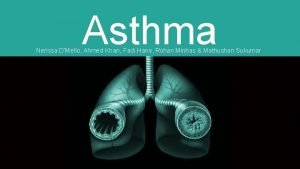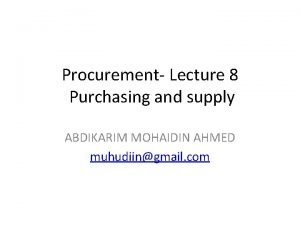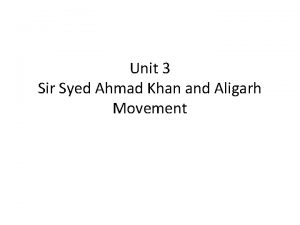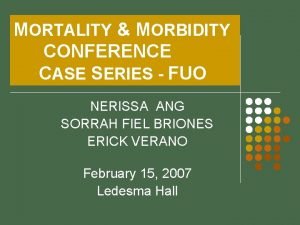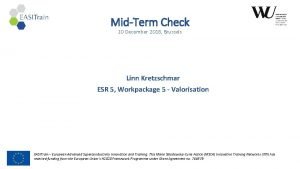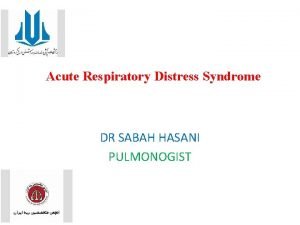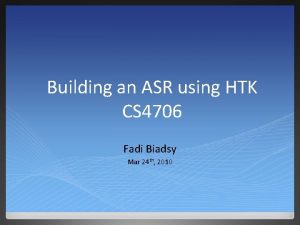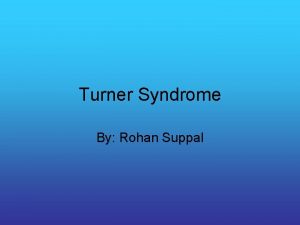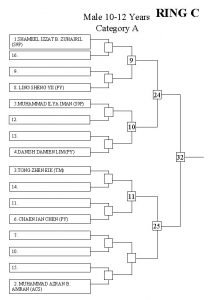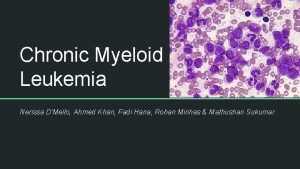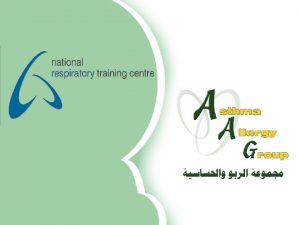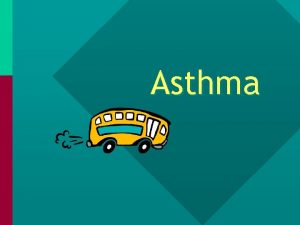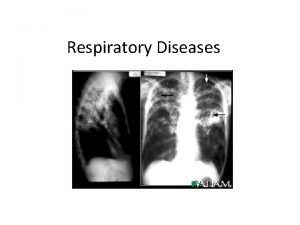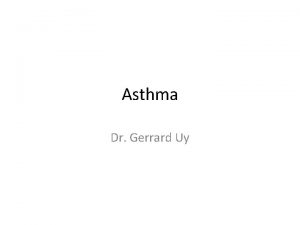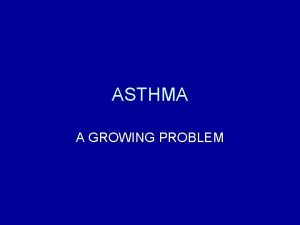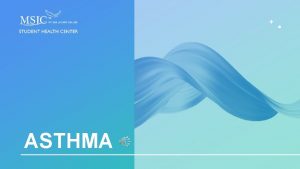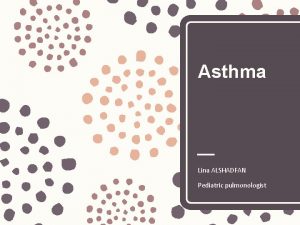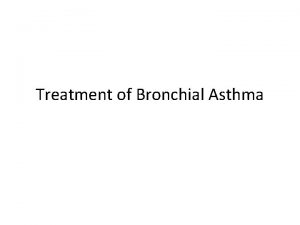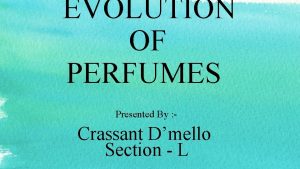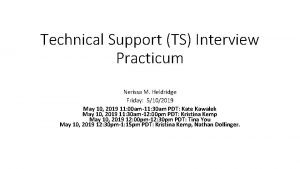Asthma Nerissa DMello Ahmed Khan Fadi Hana Rohan


















- Slides: 18

Asthma Nerissa D’Mello, Ahmed Khan, Fadi Hana, Rohan Minhas & Mathushan Sukumar

Table of Contents 1. Introduction 2. Signs and Symptoms 3. Diagnosis 4. Pathogenesis 5. Pathophysiology 6. Treatments 7. Conclusion

Video: Asthma https: //www. youtube. com/watch? v=7 EDo 9 p. UYv. PE

Introduction ● Asthma is a chronic inflammatory disease that leads to airway constriction and airway hyperresponsiveness ● About 300 million people affected worldwide ○ ● 250, 000 deaths annually Asthma can be divided into two forms: ○ Allergic asthma: ■ Most commonly found in children ■ An allergic sensitization causes progression of asthma ● Interaction between the Ig. E antibody in the body and the inhaled/ingested allergen ○ Non - allergic Asthma: ■ Most commonly found in women ■ This form is hard to treat and requires a more long-term intervention

Epidemiology ● Prevalence of Asthma varies around the world ● Mostly prevalent in developed countries (US, Canada, Australia) ● Factors like increased industrialization, lifestyle and environmental factors ● Increased prevalence of this disease is leading to increased mortality over time ○ 75% increase in prevalence observed between 1980 and 1994 ■ Greatest increase in children and young adults ○ Might be due to greater awareness from the public and earlier detection times

Risk Factors 1. Heredity a. Two asthmatic parents → 80 - 90% chance of developing asthma; one asthmatic parent → 30 - 40% chance of developing asthma; Family history of asthma → four time increase of developing asthma 2. Environment of the Fetus a. b. c. Mother’s exposure to allergens in the first 22 weeks of gestation Bronchial hyperresponsiveness mostly found in infants with lower birthweight as opposed to infants with a higher birthweight Mothers younger than 20 years and those who smoke 3. Environmental factors a. b. c. d. e. f. Environmental exposures to allergen early in life Urban environments - indoor/sedentary lifestyle Overuse and misuse of Antibiotics Vitamin C deficiency and diets low in Omega 3’s Exposure to infections Family size

Signs and Symptoms Mostly physiological abnormalities affecting lung function; sometimes cardiac performance Checklist: 1. Ability to sleep in the night 2. Coughing associated with tachycardia 3. Wheezing 4. Dyspnea- difficulty breathing Triggers can be attributed to emotional stress faced by children→ Anxiety attacks

Signs and Symptoms Combination of factors exacerbate activity and the overall inflammation in the airway May just have one of the symptoms, or all at once Can be mistaken for other diseases due to range of common symptoms Highly dependent on each person: asthma attacks, long periods without asthma, symptoms once a day, or only during fitness activity.

Diagnosis Studies indicate 50 -80% children develop asthma-like symptoms < 5 years old Misdiagnosis is common as these symptoms are representative of most respiratory malfunction: chronic bronchitis, pneumonia, infection etc. Prognosis directed towards family history of asthma as an allergy, or prenatal exposure to secondhand smoke and allergens In children→ hard to obtain qualitative measurements indicating impairment of lung function In adults→ more easier since physicals are conducted more frequently, assess quality of life as adult ages, annual checkups

Pathogenesis What initiates the inflammatory process in the first place is still being investigated New observations suggest that the origins of asthma occurs early in life Asthma is a complex and interactive process that depends on the interplay between Host factors: particularly snips and gene markers that are hereditary Environmental exposures such as: allergens, chemical irritants, cold air, exercise, medications

Pathophysiology Chronic disease of the respiratory system involving: Bronchoconstriction- narrowing of airway overdeveloped mucous glands airway thickening/bronchial inflammation obstruction of the air flow wheezing and shortness of breath Involves interplay and combined effect of many cells and signals

Pathophysiology: Normal Response Normally airborne antigens are sampled by antigen presenting cells (i. e. dendritic cells) at the bronchial mucosa The barrier function of the mucosa remains intact via tight junctions and ensures mucociliary clearance Treg cells induce self tolerance and suppress allergy and immune response Treg cells are non-inflammatory regulatory T cells which help mediate immunological tolerance Treg cells secrete IL-10 or TGF-beta signals

Pathophysiology: Normal Response Con’t T reg cells: inhibit dendritic cells inhibit T cells which promote inflammation of airway and bronchoconstriction inhibit B cells from producing Ig. E which leads to inflammation caused by histamine production inhibit mast cells, eosinophils and basophils which cause inflammation and mucous via histamine and prostaglandin release

Pathophysiology: Asthmatic Response The barrier is disrupted causing leaky basement membrane and no mucociliary clearance Number of dendritic cells increase Gives rise to T helper 2 cells (Th 2) cells which activate inflammatory cells Causes inflamed airways, release of inflammatory mediators, and epithelial damage I. e. Ig. E dependent release of mediators from mast cells such as histamines and prostaglandins that directly contract smooth muscle I. e. T helper 2 cells induces eosinophilic inflammation

Treatments - Management • No permanent cure • Management techniques implemented to alleviate symptoms of disease • Avoid irritants that lead to inflammation of the airway • Symptom relief from short-term medication • i. e. Inhalers such as Ventolin • Symptom relief from long-term medication • Daily supplements that aid in the control to help prevent future aggravation of symptoms

Treatments - Therapeutics • Inhalers – Bronchodilation • Classified as beta-agonists • Ventolin / Albuterol • Bind to beta-adrenergic G-protein coupled receptors (GPCRs) of bronchial smooth muscle • Leads to production of cyclic AMP (c. AMP) • c. AMP pathway signals relaxation of smooth muscle cells • Formoterol • Similar mechanism to Ventolin • Long-term solution as therapeutant remains at level of the cell-membrane for larger periods of time • Also binds to beta 2 -adrenergic receptors on mast cell membrane • Reduction in histamine release (inflammatory agent)

Treatments - Therapeutics • Inhalers – Anti-inflammatory corticosteroids • Pathway • Minute 1 – Drug reaches target cells • 1 -30 Minutes – Bronchial vasoconstriction resulting in closure of vascular microleaks • Few Hours – Transcription factor activation post-binding to glucocorticoid receptor • Relaxation of bronchial smooth muscle • Combination drug therapy • i. e. Symbicort • Commonly used inhaler combining bronchodilators and anti-inflammatory medication • Results in synergistic effect • Anti-inflammatory efficiency increased in presence of bronchodilators such as Formoterol

References Bacharier, L. B. , Boner, A. , Carlsen, K. H. , Eigenmann, P. A. , Frischer, T. , Götz, M. , . . . & Platts ‐Mills, T. (2008). Diagnosis and treatment of asthma in childhood: a PRACTALL consensus report. Allergy, 63(1), 5 -34. Bryan, S. A. , Leckie, M. J. , Hansel, T. T. , & Barnes, P. J. (2000). Novel therapy for asthma. Expert opinion on investigational drugs, 9(1), 25 -42. Chiang, L. C. , Ma, W. F. , Huang, J. L. , Tseng, L. F. , & Hsueh, K. C. (2009). Effect of relaxation-breathing training on anxiety and asthma signs/symptoms of children with moderateto-severe asthma: a randomized controlled trial. International Journal of Nursing Studies , 46(8), 1061 -1070. Cohn L, Elias JA, Chupp GL. Asthma: mechanisms of disease persistence and progression. Annu Rev Immunol. 2004; 22: 789 -815. Review Keller, M. , Lowenstein, S. (2002). Epidemiology of Asthma. Seminars in Respiratory and Critical Care Medicine, 23(4). 317 -329. Kuna, P. , & Kuprys, I. (2002). Symbicort Turbuhaler: a new concept in asthma management. International journal of clinical practice, 56(10), 797 -803. Lambrecht, B. , Hammad, H. (2015). The Immunology of Asthma. Nature Immunology, 16(1), 45 -56. National Asthma Education, Prevention Program (National Heart, & Blood Institute). Second Expert Panel on the Management of Asthma. (1997). Expert panel report 2: guidelines for the diagnosis and management of asthma. DIANE Publishing. National Asthma Education and Prevention Program, Third Expert Panel on the Diagnosis and Management of Asthma. Expert Panel (Report 3): Guidelines for the Diagnosis and Management of Asthma, Bethesda (MD): National Heart, Lung, and Blood Institute (US); 2007 Aug. Section 2, Definition, Pathophysiology and Pathogenesis of Asthma and Natural History of Asthma. Available from: http: //www. ncbi. nlm. nih. gov/books/NBK 7223/ Pauwels, R. A. , Löfdahl, C. G. , Postma, D. S. , Tattersfield, A. E. , O'Byrne, P. , Barnes, P. J. , & Ullman, A. (1997). Effect of inhaled formoterol and budesonide on exacerbations of asthma. New England Journal of Medicine, 337(20), 1405 -1411. Pawankar. (2014). Allergic diseases and asthma: a global public health concern and a call to action. World Allergy Organ J. , 7(1), 12.
 Fadi hana
Fadi hana Cardiac asthma vs bronchial asthma
Cardiac asthma vs bronchial asthma Ahmed muhudiin ahmed
Ahmed muhudiin ahmed Mohammedan anglo oriental defence association
Mohammedan anglo oriental defence association Components of pakistan ideology
Components of pakistan ideology Early life of sir syed ahmed khan
Early life of sir syed ahmed khan Sir syed ahmed khan father name
Sir syed ahmed khan father name Nerissa ang
Nerissa ang Msc nerissa current position
Msc nerissa current position Launcelot character sketch
Launcelot character sketch Pomalidomide uspit
Pomalidomide uspit Fadi hasani
Fadi hasani Fadi biadsy
Fadi biadsy Fadi pronunciation
Fadi pronunciation Rohan suppal
Rohan suppal Ring
Ring Rohan byanjankar
Rohan byanjankar Mandy gio twitter
Mandy gio twitter Rohan suryavanshi wharton
Rohan suryavanshi wharton
